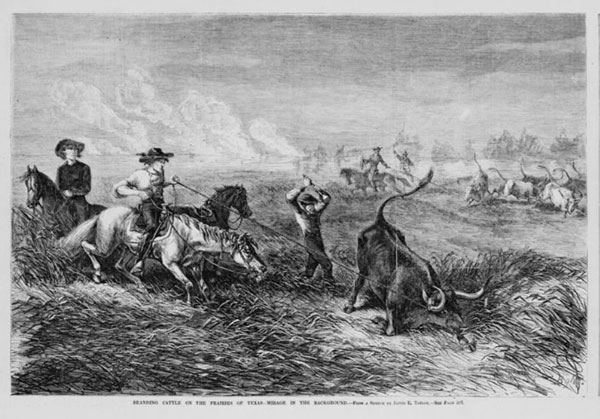
I am having an absolute Writer’s Block right this minute. The deadline is only hours away. I feel like those Parisians just before the guillotine dropped. My mind keeps going to a presentation I will make next Thursday in Lafayette, Louisiana. It’s one of my favorite all-time papers I have ever done. So, please allow me to share parts with you.
In an effort to ease national suffering and mental anguish during the Great Depression and World War II, motion picture studios created a new genre, the western movie where good guys wore white hats and rode off in the rose-colored sunsets. The general public believed that the cattle industry emerged full blown immediately after Lee surrendered to Grant. Such was not the case!
Texas was literally land and cattle poor in the first half of the 19th century. Numerous anecdotal accounts mention the availability of wild cattle on Texas prairies even before 1800. Those cattle were descendants of six or seven Andalusian heifers and a young bull brought to New Spain by Hernando Cortes in 1521. The Spanish breed was known for its muscular bodies, long legs, and wide horns. By 1690 several Spanish expeditions brought native livestock to places like Texas.
Like all cattle, New World herds tended to stray in search of better grass and sufficient water. Over the years they had ample opportunities to roam a vast area now known as Texas and Mexico. Horns widened to give the animals an advantage in brush, long legs allowed the animals to travel to better grazing locations with less stress and in the process the animals actually gained weight. A typical Andalusian cow produced a calf every year with little difficulty. Hence the large numbers of wild cattle found between the Colorado and Rio Grande Rivers by the middle of the 18th century.
At the beginning of the American Revolution, Bernardo de Galvez became the fifth Spanish governor of Louisiana. Politically anti-British he supplied Colonial North American rebels with much needed supplies in Spanish Florida and denied British ships the opportunity of invading the American rebels along the Mississippi River. Tejano stock raisers from the region south of the Nueces drove herds of longhorn cattle to Galvez’s army at the mouth of the Mississippi River in support of the Spanish effort. Those Tejano stockmen are today considered American patriots.
During the Texas Revolution both Anglo and Tejano stockmen supplied the struggling nation with beef for soldiers and refugees. Noah Smithwick reported serving in a ranging company instructed to forage supplies for both the army and civilians in the Runaway Scrape. Feral cattle were often only a few miles off the trails.
When General Zachary Taylor arrived in Corpus Christi in 1846 he hired Tejano stockmen to provide beef and transportation for supplies to the Rios Grande, 174 miles to the south. The contractors ably handled the hot, dry work. Yet, Texas stockmen needed more than wars to furnish marketing opportunities for their extensive herds.
Most Texas land had fertile grass as tall as the underbelly of a horse and adequate water. Beef cattle on the open range increased in numbers each year. But reliable markets were needed. To get to those markets required transportation, the one variable missing.
Next week I will continue with cattle trails east and west, not north. I will tell of special steamers made exclusively for cattle.
